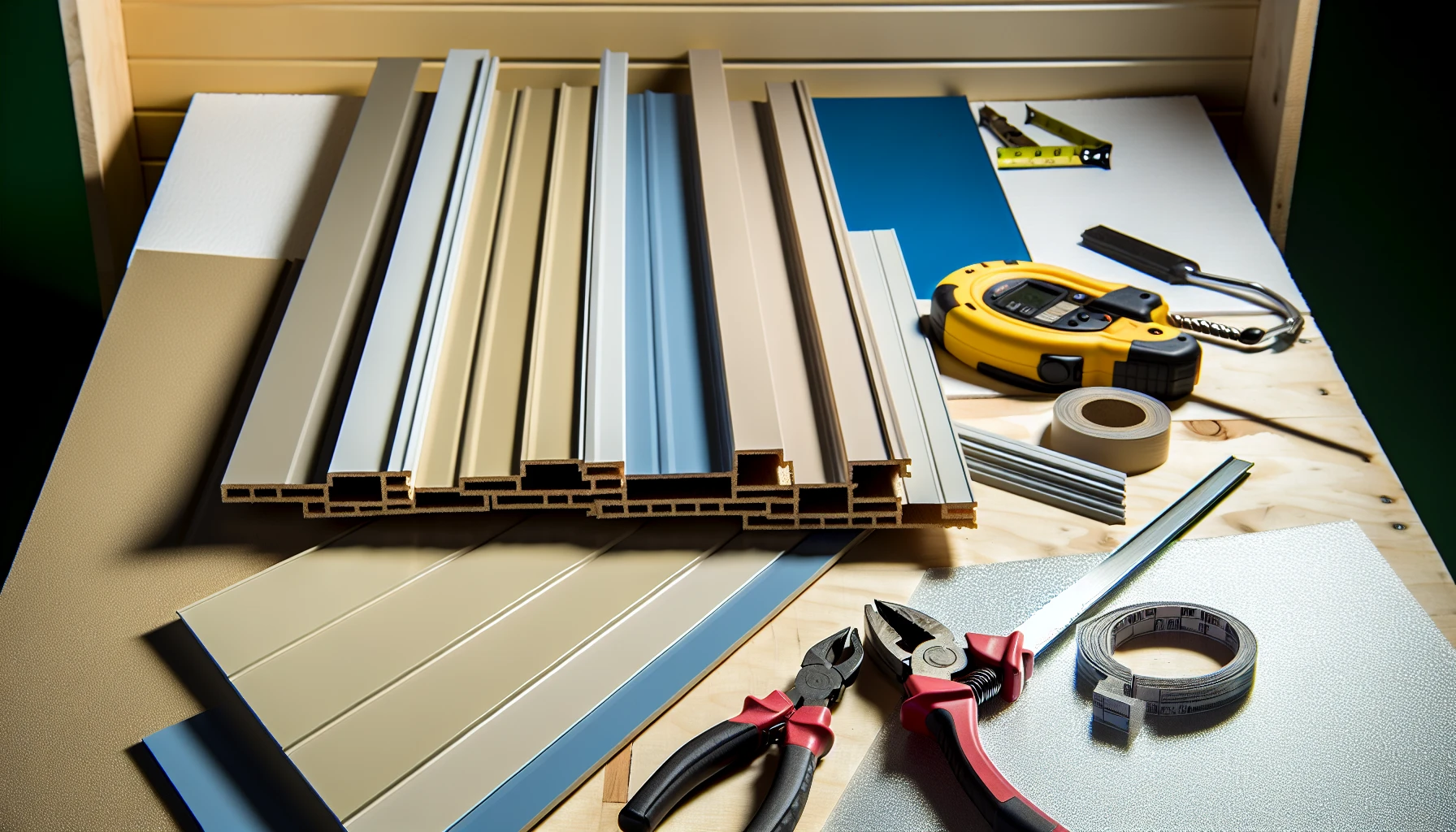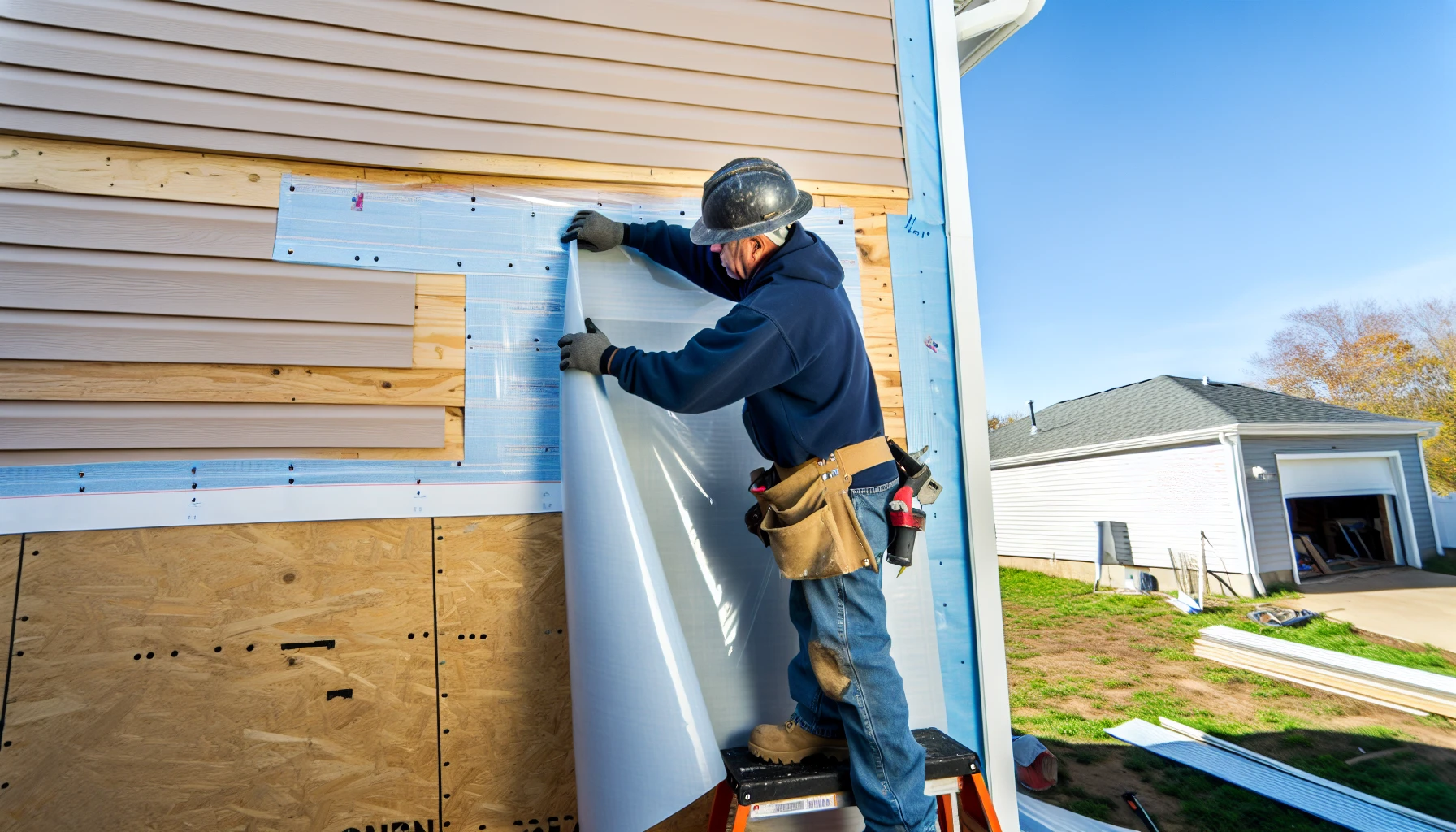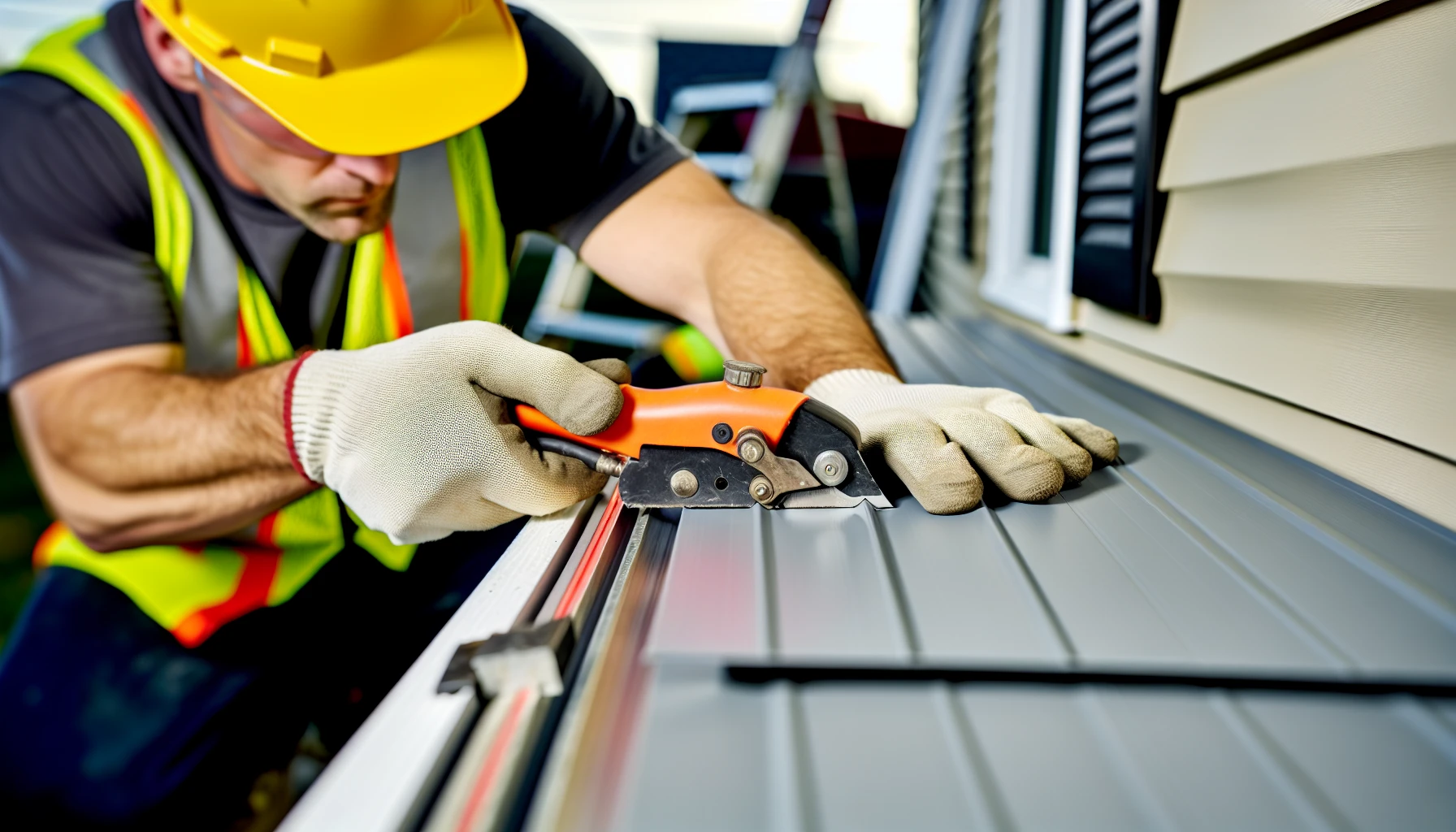Imagine transforming your home’s exterior appearance with a durable and low-maintenance solution that also provides significant cost savings. Vinyl siding offers these benefits, and with the right tools and guidance, you can successfully install it yourself. In this comprehensive guide, we will walk you through the process of installing vinyl siding like a pro, covering essential tools, measuring and prepping, laying the groundwork, and more.
Key Takeaways
- Essential tools and materials are necessary for a successful vinyl siding installation.
- Properly measure the exterior of your home, select appropriate vinyl siding based on climate and design, gather supplies, install moisture barriers and starter strips/trim to lay groundwork.
- Clean regularly with warm water or vinegar mixture. Address repairs promptly for optimal maintenance & longevity.
Essential Tools and Materials for Vinyl Siding Installation

Variety of vinyl siding panels and tools for installation
For a successful vinyl siding installation, it’s necessary to have the appropriate tools and materials ready. Selecting the appropriate siding, such as the popular Dutch lap style, and gathering necessary supplies like vinyl soffit, are crucial steps.
Installation of vinyl siding can economically revamp your home’s exterior, offering savings of up to 50% compared to professional installation costs.
Choosing the Right Vinyl Siding
The success of your project depends on the correct selection of vinyl siding for your home. Factors such as climate, design, neighborhood trends, and complementing colors should be considered.
For 2022, popular siding colors include:
- White
- Yellow
- Green
- Gray
- Brown
- Blue
Trending choices include dusky blue and sage green. Durable options like engineered wood siding, steel siding, fiber cement siding, and vinyl siding itself are excellent choices to withstand the test of time.
Gathering Tools and Supplies
Possessing the correct tools and supplies is a key factor for a successful vinyl siding installation. Essential tools include a hammer, utility knife, level, tape measure, saw, caulking gun, and pry bar. Supplies required are vinyl siding, house wrap or foam board insulation, 1/2-inch rigid foam sheathing, corner posts, and trim pieces.
Before starting, clear the work area of debris, clean and dry the surface, and install a water-resistive barrier to prevent incidental water intrusion.
Measuring and Prepping Your Home’s Exterior

Preparation of exterior wall with moisture barrier for vinyl siding installation
A successful vinyl siding installation heavily relies on adequate preparation. Here are the steps to follow:
- Remove easily removable obstacles and measure from the eave to the bottom of the existing siding.
- Consult local building codes for any requirements applicable to your area.
- Ensure that the sheathing is flat and smooth to create a finished look with no visible lumps or bumps.
- Have a water-resistive barrier in place on your home before the installation process begins.
- Measure the length of the exterior walls, from the eaves to the bottom of the existing siding.
- Calculate the number of vinyl siding panels needed to cover the length of the wall. Remember that the width of a vinyl siding panel is typically 8 inches.
- For older homes with uneven walls, consider using furring strips to ensure a smooth appearance in the final vinyl siding job.
By following these steps, you can ensure a successful vinyl siding installation.
Clearing the Work Area
Preparing your home’s exterior involves an important step of removing old siding. Start by detaching any attachments, such as foam, rubber, or nails, connected to the siding. Use a pressure washer with heavy-duty detergent to clean the siding and loosen any dirt or debris.
For vinyl siding, employ a zip tool to separate the planks for removal. Dispose of the removed vinyl siding panels and trim pieces responsibly by recycling them, reusing them, or donating them to someone who can use them.
Installing a Moisture Barrier
The installation of a moisture barrier is necessary to protect your home from water damage. House wrap and water-resistant barriers such as building paper or felt paper are typically used for this purpose.
Different types of moisture barriers are appropriate for different climates or home types, with vapor barriers installed on the exterior of the wall in warmer climates and on the interior in colder climates.
Laying the Groundwork with Starter Strips and Trim
The foundation of your vinyl siding installation is established by installing starter strips and trim. The starter strip ensures that the siding is installed in a level fashion, as intended. Installing J-channels around windows and doors by placing them securely against the casing and nailing them to the wall is also important.
Before attaching the wall siding pieces, place 1/2 inch foam sheathing strips on either side of each corner of the house.
Setting Up Starter Strips
A smooth and level siding installation necessitates a proper setup of starter strips. Here’s how to do it:
- Situate the starter strip along the chalk line, ensuring it is aligned accurately.
- Attach a 3 1/2-inch strip of 1/2-inch plywood above the indicated position on the walls.
- Nail the starter strip to the plywood.
Installing corner posts is also essential for a successful vinyl siding project, as the corner post provides stability and support to the structure.
Trimming Windows and Doors
To achieve a polished and professional look, install trim around windows and doors. Here’s how:
- Mark the siding with lines 2-2 1/2” from the window.
- Use a plywood blade in a circular saw in reverse to cut the siding.
- Cut the siding slightly short, approximately 1/4”, to account for expansion and contraction.
This method also applies to corner siding pieces.
Installing Panels, Soffit, and Fascia

Installation of soffit and fascia on a house exterior
With the groundwork in place, the next step is to install the panels, soffit, and fascia. Begin by utilizing a starter strip as a reference and commencing at the bottom of the wall. Attach each length of fascia siding by hooking its bottom lip under the starter strip, sliding it into the corner, and affixing it with nails every 16 inches.
Soffit and fascia installation includes securing J-channels under the fascia along the inner edge, as well as installing a gutter apron to protect the structure.
Attaching the First Row of Siding
When attaching the first row of siding panels, maintaining the proper alignment is important. Utilize a level to check alignment and verify that it is horizontally level and aligned with the rest of the siding on the wall. Apply a little upward pressure as each piece is nailed to ensure the panels are locked together securely without over-tightening.
Working with Soffit and Fascia
For a seamless appearance, it’s important to work carefully with soffit and fascia. Secure the upper portion of the fascia with 4D galvanized or pre-painted nails, spaced at intervals of a few feet.
For the soffit area, panels should be 1/4 inch shorter than the actual length of the soffit. If your home does not have a boxed soffit return, the ends of the soffit lengths can be concealed with the utility trim of the siding afterwards.
Precision Cutting and Fitting Techniques

Precise cutting of vinyl siding for a professional fit
Precision cutting and fitting techniques are required to achieve a professional-looking vinyl siding installation. Some essential aspects of a successful installation include:
- Properly cutting vinyl siding
- Ensuring a perfect fit around windows and doors
- Dealing with obstructions
- Working around permanent utility equipment
By following these techniques, you can ensure a high-quality vinyl siding installation.
Making Accurate Cuts
For accurate cuts in vinyl siding, use a circular saw with a fine-toothed blade, tin snips, or a utility knife. Measure and mark accurately prior to making the cuts for a perfect fit around windows, doors, and other obstacles. Avoid cracks or splits by using a cutting template or carpenter’s square, holding the snips firmly in your dominant hand, gripping the siding tightly in your other hand, and slowly sawing off the excess siding. After cutting, use a snap lock punch tool to create a secure connection between the siding panels.
Ensuring Proper Fit Around Obstacles
It’s important to ensure the proper fit and alignment of siding panels around various obstacles. When installing vinyl siding around obstructions, slide the notched lengths under the faucet from the sides.
To install siding around permanent utility equipment, nail insulation backing board around it and trim the sides and top with J-channel.
Nailing and Fastening Best Practices

Nailing and fastening techniques for vinyl siding installation
Correctly securing your vinyl siding will ensure a durable installation. Best practices include:
- Using corrosion-resistant nails, staples, or screws
- Spacing nails 12 to 16 inches on-center
- Avoiding face-nailing
- Considering any limitations with respect to wind load design pressure rating when using staples.
Nail Placement and Lengths
For optimal siding attachment, the nail placement and lengths need to be accurate. Recommended nail lengths for vinyl siding installation are between 1 1/4 inches and 2 inches, ensuring that at least 3/4 inch of the nail is embedded into the home’s wood sheathing.
Place the nails at 16 inches on center, into the studs, using aluminum, galvanized steel, or other corrosion-resistant nails that penetrate at least 3/4 inch into the siding.
Securing Siding Panels Without Over-tightening
Securing siding panels without over-tightening allows for expansion and contraction. To achieve this, apply a little upward pressure as each piece is nailed, ensuring the panels are locked together securely without over-tightening.
Finishing Touches: Top Row and Detail Work
After the vinyl siding panels are installed, it’s important to add the finishing touches to your project. This includes installing the top row of siding and adding detail work, such as vertical trim pieces and corner caps.
Installing the Top Row of Siding
To complete your vinyl siding installation, follow these steps:
- Install the top row of siding for a polished and finished appearance.
- Use a crimping tool to fasten aluminum clips to the top edge of siding.
- Alternatively, you can use a siding punch to ensure a secure attachment.
By following these steps, you can achieve a professional and secure vinyl siding installation.
Adding Vertical Trim Pieces and Corner Caps
Adding vertical trim pieces and corner caps provides a professional finish to your vinyl siding project. Here’s how to do it:
- Install under sill trim at the soffits and crimp the siding to fit the trim.
- Trim the sides and top with J-channel.
- Cut a top cap to meet the flanges of the vertical pieces.
Maintenance and Care for Your New Vinyl Siding
With proper maintenance and care, your new vinyl siding will maintain its aesthetics and durability. With just yearly cleaning, you can ensure your siding remains in top condition for years to come.
Regular Cleaning Recommendations
Cleaning your vinyl siding at least once or twice a year will maintain its appearance and longevity. Here are some tips for cleaning your vinyl siding:
- Use warm, soapy water or a mixture of vinegar and water for cleaning.
- Use a brush or a pressure washer set to a low PSI setting (around 1900 PSI).
- Avoid using hot water or high-pressure settings, as they can cause damage to the siding.
Addressing Repairs and Replacements
Should your vinyl siding get damaged, it’s imperative to promptly handle repairs and replacements. To replace damaged siding, follow these steps:
- Remove the sections from the top and work your way down to the damaged section.
- Expose the nails holding the siding in place.
- Replace the damaged section with a new one.
Vinyl siding typically lasts between 30 to 40 years with regular cleaning and minor maintenance.
Summary
In conclusion, installing vinyl siding is a cost-effective and transformative home improvement project that can be accomplished with the right tools, techniques, and guidance. By following the steps outlined in this comprehensive guide, you can successfully install vinyl siding like a pro and enjoy the benefits of a low-maintenance and durable exterior for your home.
Frequently Asked Questions
Can I install vinyl siding myself?
Although installing vinyl siding yourself can save money, it requires a lot of time and skill to do it correctly. You’ll need complete installation instructions, plus tools like a zip tool, circular saw, and pry bar. Consider hiring a professional if you have never installed vinyl siding before.
What is the proper way to hang vinyl siding?
When hanging vinyl siding, start by removing the old material and attaching sheathing and flashing. Install the starter strip and place inside and outside corner posts, before capping the corner posts and adding J-channel trim around doors and windows. Make sure the bottom of the starter strip is at least 1 in. wide and the panels are fully locked along the length of the bottom. Lastly, snap the bottom of the panel into the starter strip and nail it to the wall, leaving a 1/4-inch space at each panel meeting.
What is the most common mistake when installing vinyl siding?
The most common mistake when installing vinyl siding is not leaving enough overlap between panels, which results in a messy and unkempt look. The industry standard for this overlap is between one and one-and-a-quarter inches.
Can I install vinyl siding over my existing wood siding?
Yes, you can install vinyl siding over your existing wood siding.
How do I choose the right color and style for my vinyl siding?
When choosing vinyl siding for your home, take into account climate, design, neighborhood trends, and complementary colors to determine the best color and style for your property.

